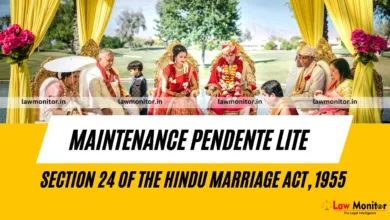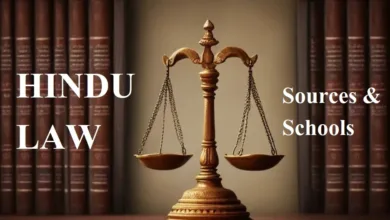Theories of Divorce under Hindu Law – Full Notes
In Hindu Law, there exist several theories explaining divorce, delineating how a married couple can legally part ways. These theories serve as the rationale behind the dissolution of marriages.

In Hindu Law, there exist several theories explaining divorce, delineating how a married couple can legally part ways. These theories serve as the rationale behind the dissolution of marriages.
The primary theories for divorce under Hindu law are the Guilt or Fault Theory, Mutual Consent Theory, and Irretrievable Breakdown of Marriage.
Read also:
- Schools of Hindu Law: Concepts, Advantages, Criticism
- Hindu Law Notes: Origins, Sources and Schools of Hindu Law
Guilt/Fault Theory of Divorce
According to the guilt theory, a marriage can be dissolved if one spouse commits a matrimonial offense. This theory hinges on the concept of an innocent and a guilty party, where only the innocent party can seek divorce. However, a significant limitation arises if both parties are at fault, leaving no recourse for dissolution.
The Hindu Marriage Act of 1955, as amended in 1976, enumerates nine grounds based on the guilt theory, including adultery, cruelty, desertion, insanity, conversion, venereal disease, leprosy, renunciation, and presumption of death. These grounds provide legal justifications for divorce if one party is found guilty of an offense. Notably, the innocent party must substantiate the guilt of the other party in court for divorce to be granted under this theory.
Adultery:
Adultery, defined as consensual extramarital affairs, is considered a grave offense under the guilt theory. Even under ancient Hindu law, adultery was condemned. The Hindu Marriage Act, as amended in 1976, recognizes even a single act of adultery as grounds for divorce. Evidence for adultery can be established through various means, including circumstantial evidence or the contraction of venereal disease.
In Swapna Ghose v. Sadanand Ghose, the court found sufficient evidence of adultery when the wife found her husband and the adulteress lying together on the bed at night.
Cruelty:
Cruelty, encompassing both physical and mental forms, refers to behavior that adversely affects marital relations. Acts such as false accusations, demand for dowry, impotence, and mental abuse constitute cruelty under this theory.
| Join Telegram Group | Click Here |
| Join WhATSAPP channel Agra University | Click Here |
In Pravin Mehta v. Indrajeet Mehta, the court has defined the cause of mental cruelty as the ‘state of mind.’
Desertion:
Desertion occurs when one spouse abandons the other without cause and without consent, fulfilling specific conditions such as a prolonged absence and lack of intent to return.
The following five conditions must be co-existing to constitute desertion as a ground for divorce: animus deserdendi, the factum of separation, desertion without the consent of the other party, desertion without any reasonable cause and de jure period of two years must have run out before filing a petition.
In Bipinchandra v. Prabhavati, the court states that where the respondent leaves the matrimonial home with an intention to desert, he will not be guilty of desertion if he subsequently shows an intention of returning but is prevented from doing so by the petitioner.
Insanity or Mental Disorder:
Divorce can be sought if one spouse suffers from incurable mental illness, rendering cohabitation unbearable for the other.
Conversion:
If one party converts to another religion, it constitutes grounds for divorce under Hindu law.
Venereal Communicable Disease and Leprosy:
The presence of communicable diseases like venereal disease or leprosy is recognized as grounds for divorce.
Renunciation:
If one spouse renounces worldly life, entering a holy order, divorce can be sought under Hindu law.
Presumption of Death:
If a spouse is unheard of for seven years, they can be presumed dead, allowing the other spouse to seek divorce.
Wife’s Grounds for Divorce
According to Section 13(2) of the Hindu Marriage Act, 1955, the guilt or fault theory of divorce offers four additional grounds on which a wife can seek divorce from her husband:
- Pre-Act Polygamous Marriage: If the husband has another living wife at the time of marrying the petitioner, from before the Act came into effect.
- Rape, Sodomy, or Bestiality: If the husband has committed any of these acts after the marriage.
- Discontinuance of Cohabitation after an Order of Maintenance: If the wife has obtained a maintenance decree under Section 18 of the Hindu Adoption & Maintenance Act, 1956, and an order of maintenance under Section 125 of the CrPC, and cohabitation hasn’t resumed for a year or more.
- Repudiation of Marriage: If the wife has either explicitly or implicitly rejected the marriage before reaching eighteen, though married between fifteen and eighteen.
Mutual Consent Theory of Divorce
Section 13(B) of the Hindu Marriage Act allows for divorce by mutual consent, acknowledging marriage as a voluntary social contract. This theory recognizes that if both spouses agree, they should have the freedom to dissolve the marriage, contrary to the fault theory, which requires one spouse to be guilty.
Critics argue that the mutual consent theory can hinder divorce, needing agreement from both parties. Yet, if both agree, they can file a joint petition, aiming to prevent unhappy marriages and uphold marital freedom by allowing divorce.
Irretrievable Breakdown Theory of Divorce
The concept of irretrievable breakdown of marriage emerged relatively recently as a ground for divorce within Hindu Law, notably introduced in 1976 through the Marriage Laws Amendment Act within the Hindu Marriage Act.
This provision allows either party to file for divorce without the necessity of proving fault or misconduct on the part of the other. The primary condition is the irretrievable breakdown of the marriage, with no prospect of reconciliation.
This ground acknowledges that in certain circumstances, ending the marriage may be preferable to persisting in a relationship marred by acrimony or unendurable conditions. It is deemed beneficial for both parties to pursue happiness separately in such cases.
In instances where cohabitation is untenable and efforts at reconciliation have proved futile, it may be more pragmatic to dissolve the marriage through mutual consent rather than maintain a hollow union. This theory operates on the presumption of an effective breakdown in the relationship, particularly if the spouses have lived apart for an extended period, with or without reasonable cause.
The landmark case of Naveen Kohli v. Neelu Kohli exemplifies this principle, where the court deemed the marriage beyond repair due to serious allegations of misconduct. The Supreme Court, in this instance, advocated for the inclusion of “Irretrievable Breakdown of Marriage” as a distinct ground for divorce under Section 13 of the Hindu Marriage Act, urging legislative amendment.
The 71st Report by the Law Commission of India in 1978 scrutinized the Irretrievable Breakdown of Marriage theory, deliberating its conditions, applicability, and potential inclusion within the Hindu Marriage Act. Presently, only the Supreme Court holds the authority to grant divorce on this basis.
Conclusion
The Hindu Law offers various theories of divorce, each providing distinct avenues for marital dissolution. The fault or guilt theory necessitates proving matrimonial misconduct by one spouse. Mutual consent theory allows both parties to separate by mutual agreement. Meanwhile, the irretrievable breakdown theory, though not yet enshrined as a separate ground in the Hindu Marriage Act, finds acknowledgment through judicial interpretation, notably by the Supreme Court.


